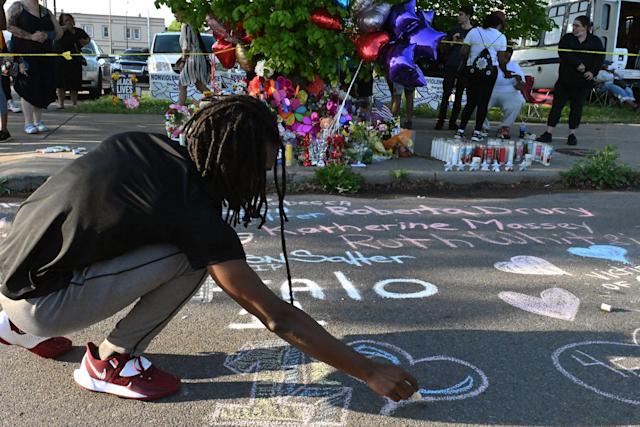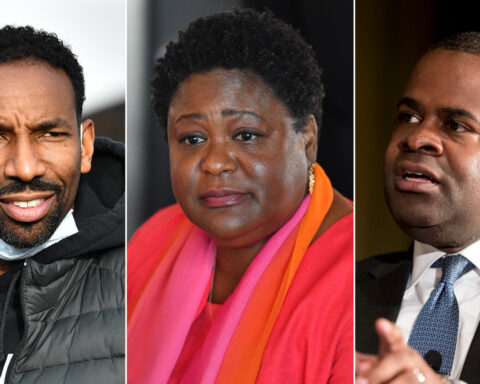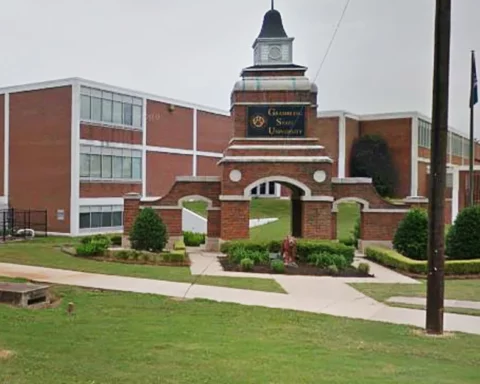Local leaders call on Mayor Byron Brown to commit to fixing concerns that have been amplified by the killing of 10 Black people at a Tops supermarket.
The national media has packed up and moved on to the next mass shooting in America. But residents on the eastside of Buffalo, where 85 percent of the population is Black, are still grieving — while also trying to figure out how to rebuild.
“This isn’t one of those situations where we can just go on with our daily lives,” said Jillian Hanesworth, Buffalo’s first poet laureate and a social justice activist working for the organization Open Buffalo.
The May 14 massacre magnified the plight of a community that had long been disadvantaged before 10 Black people were gunned down by a white supremacist at a supermarket.
Through horror and grief — and in some ways, inspired by it — Black Buffalonians see a desperate need for substantial, community-wide change that goes beyond reopening the Tops Friendly Market.
Through tears, they say they view the massacre as an inflection point to exposing and fixing the many deficits in the city’s Black community. And they charge Buffalo’s first Black mayor, Bryon Brown, with being at the forefront of this revitalization.
Hanesworth said Open Buffalo is working to meet people’s immediate needs, “but at this point, it’s life or death for this community. Much has to happen on the other side of this.”
The targeted attack took place at what has been the sole grocery store in Buffalo’s Black neighborhood for nearly 20 years. That dubious distinction aside, the store became the center of the neighborhood, a gathering spot, amplifying the impact of the slaughter.
“Tops not only served as a grocery store, but there was a pharmacy there where the community had prescriptions filled,” said Thomas Beauford, president of the Buffalo Urban League. “Many people would cash their paychecks there. And they used Tops to buy money orders to pay a bill. All of that’s gone.”
The fact that the store is now closed — and will be for some time — makes the area’s recovery harder because so many people relied on this one resource.
Despite the market’s crucial standing in the neighborhood, the sentiment had been that the Tops on Jefferson “didn’t have the same level of investment” as stores in Buffalo’s white neighborhoods, Beauford said. “It was already inferior, but it’s all we had.”
Hanesworth said she has been on the ground since the shooting, working in various capacities to help heal and fill the gaps that have been created by the shooting. “People here are fed up,” she said.
“Our people are starving, and they were starving before May 14, 2022,” she said. “I am glad that the community is pulling together. We’re making sure that people eat not only through donations and organizations graciously helping out, but also through providing shuttles to take shoppers to other grocery stores in the city.”
“But,” Hanesworth added, “we shouldn’t have to be shuttled out of our community to buy groceries.”
The median income in east Buffalo is $42,681, according to the 2021 U.S. census, and many residents in east Buffalo do not own cars and rely on public transportation to get around. The census says that the median income of Black households in Buffalo increased only $2,650 from 1990 to 2020.
In every social category — services, job wages, transportation, employment opportunities and health disparities among them — Black people in east Buffalo lag significantly behind white residents and have seen little progress in 30 years, according to The Harder We Run, a 2021 study by Henry Louis Taylor, a University of Buffalo professor of urban studies.
“Dr. Taylor’s study tells it all,” said Dorothy Hill, an 87-year-old native who remains active in social issues. “We have been so demoralized in east Buffalo for years, decades. And that’s just unacceptable. It has to stop now.”
Beauford stressed the need to continue supporting and developing the east side of Buffalo. “And because of how the community has been ignored in the past, there is a lot of concern about if the proper investment will be made in the recovery from this tragedy.”
That’s where Brown comes in, community leaders say. He has been Buffalo’s mayor for 16 years, “and we’re in the condition we’re in under his tenure,” Hanesworth said. “That speaks volumes.”
She does credit the mayor with developing the Northland Workforce Training Center, which prepares residents for employment and provides other services, as well as hiring more Black sanitation workers. “But when you look at the overall status of the community,” Hanesworth said, “the answer is people today are just as hungry as they were prior to his tenure as mayor.
“He inherited a very racist system. But once you inherit something, you have a couple of choices: You can change it or you can keep it status quo. So, while there have been a few bright spots in our community, it has not been enough to even confront the systemic oppression that Black people face in the city of Buffalo. We need more of a commitment from him.”
The mayor’s commitment
For his part, Brown told NBC News that he and his family live in east Buffalo and that he has been and remains committed to improving the area. He added that he was assured by the president of Tops that the store will be completely renovated and eventually reopen.
Additionally, Brown said he plans to use money from the American Rescue Plan in east Buffalo to create “training programs where we can help rapidly upskill people, where people will go from training to living-wage, family-sustaining jobs. We are going to make record investments in infrastructure improvement on the east side of Buffalo and throughout the city.”
He cited several accomplishments during his tenure, including the building of the library on Jefferson and a local police precinct, hiring “the most diverse staff in the city’s history,” demolishing thousands of vacant buildings that invited crime and drugs, and raising the annual budget on youth employment.
Still, he said the burden of building or rebuilding the community should not be on him alone.
“It should be all hands on deck,” he said. “The city, the state, companies, nonprofits, everyone. But it also has to be the people of east Buffalo. People have to be more aware that government can’t be the sole actor. People have to be involved in lifting themselves as well.”
The community and many others have responded to the immediate needs. Organizations large and small have been overrun with volunteers, from Buffalo, the state and beyond. More than $3 million worth of food has been donated to the east side of the city, Brown said.
“Tremendous response to assist in healing and to help us move the community forward,” he added.
A lot is happening on the ground. At the Resource Council of West New York, FeedMore WNY, a regional food bank, has provided milk, potatoes, produce and other goods to more than 1,100 people a day under tents. People often gather and mill at the site, as they did at Tops.
Daily rallies that take place to remember or mourn the victims are emotional, but also uplifting. Hanesworth, author of the book, “The Revolution Will Rhyme,” performs inspiring, thought-provoking poems to residents.
Dorothy Hill and son Michael Hill, the director of the Langston Hughes Arts Center, are organizing local artists to set up exhibits in the area around the store as a way of inspiring, edifying and even distracting the community.
For those who need professional help in dealing with the shooting, the Buffalo Urban League has called on a cache of Black therapists to serve those seeking to make sense of the senseless for a community that prefers Black counselors for the sake of comfort and cultural competency.
The organization set up a makeshift office that welcomes the grieving. Melissa Archer, a certified psychiatric nurse and Buffalo native, heads a team of 15 that have administered counseling to more than 1,000 people, she said.
“People just walk into our office and start crying,” Archer said. “They are scared. They’re angry and they’re tired of being tired. Very frightful, depressed, anxious, especially the past couple of days, now that the media is gone and things have quieted down on Jefferson. Are they going to be left here on their own? How are they going to eat? How are they going to pick up the pieces? How are they going to stay safe? How are they going to do this on their own?
“We’ve met a lot of people that just came out of their house for the first time since it happened. They’re frustrated,” Archer said. “They don’t feel that enough is being done to protect them. But we’re working on building that resilience, that community resilience, individual resilience and family resilience.”
Rita Hubbard-Johnson said she cried the first time she rode by Tops after the shooting. A staple in the community, she and others — like Curtis Haynes, an associate professor of economics at Buffalo State College, who had proposed a food co-op for the city that was rejected — for years have pushed the local government to invest in creating healthy food options in the community. The tragedy made her more committed to doing so.
“I have to be,” said Hubbard-Johnson, the owner of NeuWater and Associates, a company that focuses on population health and social determinants of health issues. “This horrific event showed that we cannot survive on one grocery store, especially one that functions on corporate thinking about who Black people are and what they are and what they deserve or what they can get.”
Pressed on whether the eastside would get another supermarket, Brown stopped short of committing.
“After so many years, an infrastructure plan or reinvestment into this community should have already occurred,” Hubbard-Johnson said. “But I would like to think that this was an opportunity for a wake-up call for all people of power and influence in City Hall and the county government and state government — and even federal halls — because the kind of improvements needed here have been a long time coming.”




